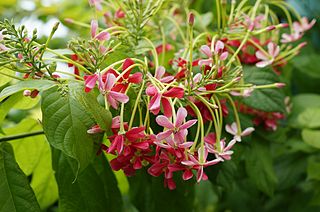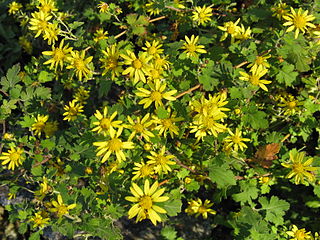
Sesame is a plant in the genus Sesamum, also called simsim, benne or gingelly. Numerous wild relatives occur in Africa and a smaller number in India. It is widely naturalized in tropical regions around the world and is cultivated for its edible seeds, which grow in pods. World production in 2018 was 6 million tonnes, with Sudan, Myanmar, and India as the largest producers.

Sesamum is a genus of about 20 species in the flowering plant family Pedaliaceae. The plants are annual or perennial herbs with edible seeds. The best-known member of the genus is sesame, Sesamum indicum, the source of sesame seeds. The species are primarily African, with some species occurring in India, Sri Lanka, and China. The origin of S. indicum is uncertain, as it is widely cultivated and naturalized in tropical regions. The genus is closely related to the strictly African genus Ceratotheca and is itself probably African in origin.

Pedaliaceae, the pedalium family or sesame family, is a flowering plant family classified in the order Lamiales. The family includes sesame, the source of sesame seeds.

The slender bamboo shark, Chiloscyllium indicum, is a bamboo shark in the family Hemiscylliidae found in the Indo-West Pacific Oceans between latitudes 40° N and 10° S, and longitude 65° E and 160° E. It is harmless to humans.

Abutilon indicum is a small shrub in the family Malvaceae, native to tropical and subtropical regions. This plant is a valuable medicinal and ornamental plant, its roots and leaves being used for curing fevers. It has been widely introduced outside of its native range, and is considered invasive on certain tropical islands.

Combretum indicum, commonly known as the Rangoon creeper or Burma creeper, is a vine with red flower clusters which is native to tropical Asia and grows in thickets, primary and secondary forest, and along river banks in the Indian subcontinent, Malaysia and the Philippines. It has since been cultivated and naturalized in tropical areas such as Burma, Vietnam, and Thailand.

Chrysanthemum indicum is a flowering plant commonly called Indian chrysanthemum, within the family Asteraceae and genus Chrysanthemum.

Heliotropium indicum, commonly known as Indian heliotrope, Indian turnsole is an annual, hirsute plant that is a common weed in waste places and settled areas. It is native to Asia. It is widely used in native medicine in Tamil Nadu, India.

Oroxylum indicum is a species of flowering plant of the monotypic genus Oroxylum in the family Bignoniaceae. It is commonly called Indian trumpet tree, oroxylum, Indian trumpet flower, broken bones, scythe tree, tree of Damocles, or midnight horror It can reach a height of 18 metres (59 ft). Various segments of the tree are used in traditional medicine.

Oroxindin is a flavone, a type of phenolic chemical compound. It is a wogonoside, more accurately a wogonin glucuronide isolated from Oroxylum indicum (Bignoniaceae), Bacopa monnieri (Plantaginaceae) and Holmskioldia sanguinea.

Oroxylin A is an O-methylated flavone, a chemical compound that can be found in the medicinal plants Scutellaria baicalensis and Scutellaria lateriflora, and the Oroxylum indicum tree. It has demonstrated activity as a dopamine reuptake inhibitor, and is also a negative allosteric modulator of the benzodiazepine site of the GABAA receptor. Oroxylin A has been found to improve memory consolidation in mice by elevating brain-derived neurotrophic factor (BDNF) levels in the hippocampus.

Rhododendron indicum is an azalea Rhododendron species native to Japan.

Annamanum is a genus of longhorn beetles of the subfamily Lamiinae, containing the following species:
Annamanum annamanum is a species of beetle in the family Cerambycidae. It was described by Stephan von Breuning in 1960. It is known from India.
Annamanum mediomaculatum is a species of beetle in the family Cerambycidae. It was described by Stephan von Breuning in 1962. It is known from Laos.
Annamanum ochreopictum is a species of beetle in the family Cerambycidae. It was described by Stephan von Breuning in 1969. It is known from Malaysia.

Annamanum lunulatum is a species of beetle in the family Cerambycidae. It was described by Maurice Pic in 1934. It is known from Vietnam and China.
Annamanum griseolum is a species of beetle in the family Cerambycidae. It was described by Henry Walter Bates in 1884, originally under the genus Uraecha. It is known from Japan.
Annamanum sinicum is a species of beetle in the family Cerambycidae. It was described by Gressitt in 1951. It is known from China.

Canarium indicum, known as galip nut, is a mainly dioecious tree native in eastern Melanesia. It is usually found in rainforests, secondary forests, old garden areas, around villages and settlements. It is also used as a shade tree, as a windbreak and in agroforestry. Canarium is important in the world food system as it can be used as a food and timber source, in traditional medicine, intercropping and agroforestry.













